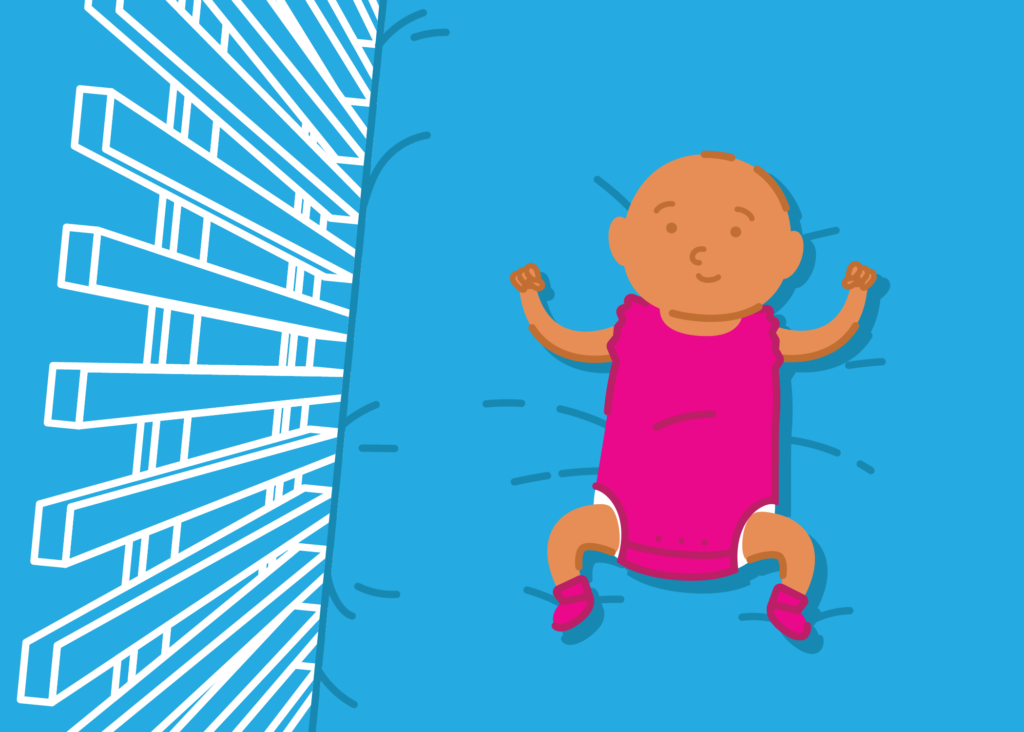Having a baby is one of the most life-changing experiences a person can have. Every day is a new adventure, and parents get the chance to nurture a young life and build a family. However, many medical conditions can threaten a baby’s life early on, and some of them may result in the loss of this important new family member. Sudden Infant Death Syndrome (SIDS), sometimes known as “crib death”, is a condition that babies less than a year old may develop that can rapidly lead to infant mortality. Here’s what you need to know about SIDS and what you can do to prevent it.
Causes of SIDS
Part of what makes SIDS so complex and devastating is that the cause of death is often unknown or unexplainable, and is therefore hard to predict or prevent. SIDS is also part of a larger category of unexpected infant deaths called Sudden Unexpected Death in Infancy (SUDI), which encompasses infant death under the age of one year whether or not the cause is explained. And while there is still much uncertainty about the nature of SIDS, research does point to several factors to watch for that may increase your baby’s risk of developing this fatal condition.
Breathing Problems & Sleeping Method
Studies have shown that infants who are laid down to sleep on their backs are less likely to develop Sudden Infant Death Syndrome. Infants who are put down to sleep on their sides or tummies may have a harder time breathing, and may breathe in the CO2 that they are exhaling, which can cause suffocation. Suffocation may also occur if the baby is laid to sleep on a soft surface like a comforter, fluffy blanket or waterbed. Because babies under one year old are generally unable to adjust themselves or roll over while sleeping, these sleep environment factors can be dangerous. Furthermore, allowing babies to overheat while they sleep can be fatal.
Even at a young age, babies are generally able to detect a change in the amount of oxygen they are able to breathe or if they are rebreathing their own CO2. If this occurs, their brains are triggered to wake them from sleep so they can adjust their heads to breathe better. However, some clinicians believe that SIDS babies are unable to rouse from slumber to help themselves breathe, which can lead to suffocation.
Physical Complications
If a baby is born prematurely, it will be at a higher risk of developing SIDS simply because it has not fully developed yet. Doctors who tend to premature babies are aware of this and do what they can to prevent these issues from developing. Other problems may arise, however, if the baby has a pre-existing physical abnormality or an early onset infection. Your doctor will be able to let you know if any of these concerns are a factor.
Familial Factors
Some other factors that can put a baby at risk for developing Sudden Infant Death Syndrome are related to the genetics and behaviors of the baby’s parents. These factors include:
- Parent(s) being under the age of 20.
- Parent(s) drinking alcohol, smoking or using drugs during and/or after pregnancy.
- Parent(s) receiving little to no (or late) prenatal care.
- Family history of SIDS, including previous child mortality in the immediate family.
Other Risk Factors
Some other more general factors also exist that have been linked to the development of SIDS or SUDI. These include:
- Sex: Boys are slightly more likely to die of SIDS than girls.
- Ethnicity: Non-Caucasian babies are more likely to contract SIDS, the reason for which is not well-understood.
- Age: Babies under the age of 1 year old are the most likely to develop SIDS, and many SIDS babies die within the first 6 months of birth.
- Low birth weight: Being born prematurely or with a low beginning weight can cause a baby to be at risk for SIDS.
What Can Be Done to Prevent SIDS?
One of the hardest things about SIDS is that not much is known about it, and therefore it can be difficult to determine how best to prevent it. One thing that most doctors can agree on, however, is that babies should be laid down to sleep on their backs so that breathing is easy. With the rate of babies who die as a result of suffocation during sleep, this is touted as being the best practice (in fact, the American Academy of Pediatrics (AAP) created a “Back to Sleep” campaign to encourage this). In addition, it’s essential to attend all your recommended OB and pediatric appointments, and ask any questions you may have about potential concerns. Your pediatrician will be able to give you other advice and assistance specific to your situation.
What to Do If You’ve Been Affected By SIDS
Losing a baby less than a year after birth is unbelievably difficult, and you may experience a wide range of emotions as you grieve. Know that your feelings are valid, and take time to process your loss. Since Sudden Infant Death Syndrome is generally an unexplained condition, it’s also important to be kind to yourself and remember that the loss of your baby was not your fault. Reach out to family and friends for assistance and let yourself work through the pain as you would with any other loved one. We also welcome you to reach out to us for comfort and next steps for your family’s well-being.
Talk to Us!
The idea of SIDS can be a scary one to new parents, which is why it’s a condition that we want to help you learn more about and prevent. If you have questions about SIDS risk and how to help your baby stay as healthy as possible, contact us today and we can connect you to one of our pediatricians!
